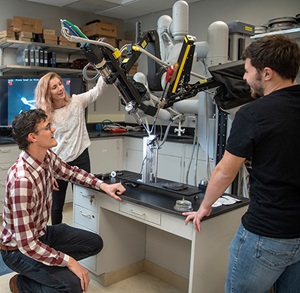The downtown Winston-Salem district formerly known as Wake Forest Innovation Quarter, home of the Wake Forest School of Medicine, has a new name—Innovation Quarter—and a renewed focus that positions it for continued growth.
According to Terry L. Hales, MBA, the changes are natural progressions in the district’s 30-year history of growth.
 “We knew early on Wake Forest’s backing and branding would be critical for Innovation Quarter,” says Hales, executive vice chief academic officer for administration and operations, and Innovation Quarter lead executive with the School of Medicine. “While Wake Forest’s commitment and engagement remains critical, we knew that at some point, Wake Forest would be but a part of Innovation Quarter. Whether it’s Wake Forest Baptist Health, the School of Medicine or the university proper, Wake Forest is a core component of the Quarter, however Innovation Quarter is now much broader than Wake Forest.”
“We knew early on Wake Forest’s backing and branding would be critical for Innovation Quarter,” says Hales, executive vice chief academic officer for administration and operations, and Innovation Quarter lead executive with the School of Medicine. “While Wake Forest’s commitment and engagement remains critical, we knew that at some point, Wake Forest would be but a part of Innovation Quarter. Whether it’s Wake Forest Baptist Health, the School of Medicine or the university proper, Wake Forest is a core component of the Quarter, however Innovation Quarter is now much broader than Wake Forest.”
Innovation Quarter now has more than 90 companies, including many in health care, research and technology. The goal is not simply to develop and fill real estate, but to organize in a manner to foster intentional collisions of traditional and nontraditional partners, focused on health care and social innovation.
A Leading Role in the New Atrium Health
 In October, the proposed combination of Atrium Health, Wake Forest Baptist Health and Wake Forest University became official. The combination promises to expand Innovation Quarter’s role and impact. Part of the vision of the new Atrium Health includes building a “Silicon Valley” for health care innovation, spanning from Winston-Salem to Charlotte, according to Eugene A. Woods, MBA, MHA, FACHE, Atrium’s president and chief executive officer.
In October, the proposed combination of Atrium Health, Wake Forest Baptist Health and Wake Forest University became official. The combination promises to expand Innovation Quarter’s role and impact. Part of the vision of the new Atrium Health includes building a “Silicon Valley” for health care innovation, spanning from Winston-Salem to Charlotte, according to Eugene A. Woods, MBA, MHA, FACHE, Atrium’s president and chief executive officer.
“The Innovation Quarter in Winston-Salem is one of just nine innovation districts in the world recognized by The Global Institute on Innovation Districts,” Hales says. “We are thrilled to have the opportunity to serve as both an anchor and driving catalyst of an evolving high-tech corridor as it expands to Charlotte.”
A Focus on Sectors
Just as the School of Medicine several years ago successfully shifted its research focus to a handful of key areas that held the greatest potential for impact and to gain national recognition, Innovation Quarter is using a similar approach.
“We applied that same thought process to Innovation Quarter and the larger innovation district,” Hales says. “While we could do a lot of things, we said there may be five or six really key areas that five to 10 years from now, we want to be known for.”
 Those key sectors are:
Those key sectors are:
- Value and Health Transformation: Using population health tools, research and approaches to help health systems and communities move to value-based models of care.
- Healthy Aging: Helping people live longer by integrating technology, exceptional research in aging and Alzheimer’s, and innovative approaches to health.
- Virtual Health: Using technology, behavioral economics and process improvement to ease access to high-quality health care, including telehealth, virtual health and retail health delivery.
- Personalized Care and Precision Medicine: Developing and refining novel approaches (such as genomics and humanoids) that account for a patient’s genetic makeup to improve health.
- Learning Systems: Exploring and refining new opportunities, technologies and approaches for experiential learning and teaching through virtual learning and other novel methods.
The key to it all is collaboration, and another recent change—the formation of iQ Healthtech Labs—encourages that. The labs will bring together Innovation Quarter tenants, traditional and nontraditional partners, commercial markets and potential investors to help shorten the time it takes to create and develop marketable healthtech solutions.
“It’s almost a matchmaker role, matching companies that are here and the great work they’re doing with traditional and nontraditional partners,” says James Patterson, who directs marketing and communications for Innovation Quarter. “When you think of health care, you may not think of UPS, but they are a nontraditional partner for us.”
UPS is a real-life example. A collaborative effort between UPS Flight Forward and Wake Forest Baptist resulted in a drone service, which debuted in summer 2020. The effort began after iQ Healthtech Labs facilitated a relationship and kept ideation and collaboration flowing between the two entities. The service is now piloting drone delivery of time-sensitive medications and medical equipment across the Wake Forest Baptist Medical Center campus.
Accelerating Collaboration
For the School of Medicine, its students, faculty and researchers are among the many assets within Innovation Quarter that can accelerate such collaborative processes.
“There’s an opportunity for Innovation Quarter, in partnership with our learning institute, to drive the future of medicine for our students,” Hales says. “Just as we are emphasizing gathering traditional and nontraditional partners in Innovation Quarter, the special advantage for those partners is the ability to access a nationally excellent clinical program, and students in the School of Medicine are part of that.”
Hales sees opportunities for students to benefit from the intersections of business and industry within Innovation Quarter as they learn medicine.
“Our health care is evolving very differently,” he says. “As it evolves, it will mean interacting with and learning from nontraditional partners. These are opportunities that Innovation Quarter is intentionally planting. We hope that we give those opportunities to new and future learners so they’re even better equipped to practice medicine.”
As an example of a potential educational partnership, Patterson cites the UNC School of the Arts, which has a presence in Innovation Quarter’s Center for Design Innovation, and its work in augmented and virtual reality (AR/VR). The right collaboration could produce a transformative educational experience.
“Imagine if you could put on an AR/VR headset and explore a model of the human body in a way that you’ve never been exposed to through a textbook,” Patterson says.
Creating opportunities for such partnerships and interactions is what Innovation Quarter is all about.
“Innovation usually happens at the intersections, when the right idea comes along and the right technology is available, or two smart ideas come together and move in a new direction,” Patterson says. “That’s where we see Innovation Quarter, as that convening point for the right companies, institutions, people and thinkers to come together and drive innovation."

